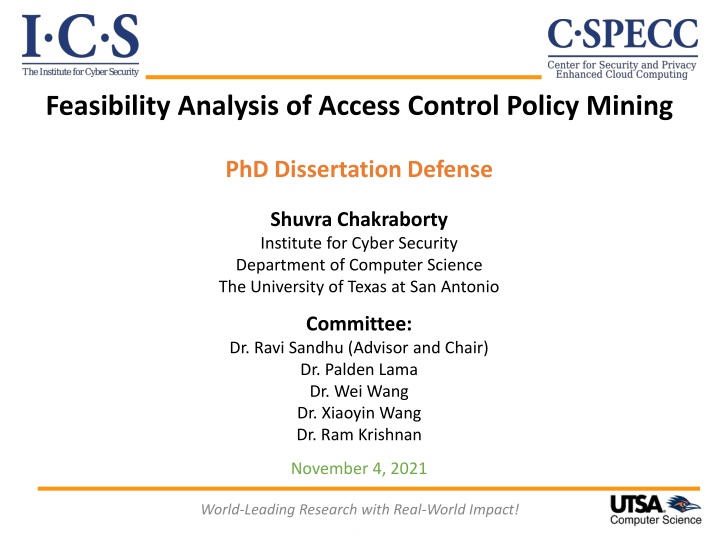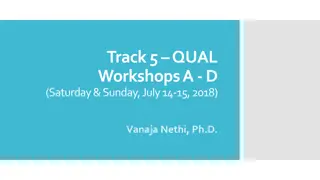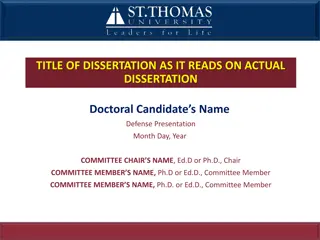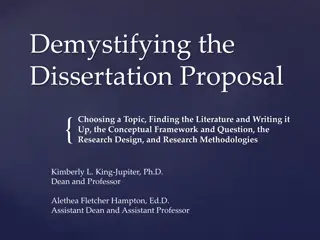
Feasibility Analysis of Access Control Policy Mining in Cyber Security
Explore the feasibility of automated access control policy mining for smooth migration between access control models. The research delves into the challenges of migration and proposes solutions to ensure precise criteria fulfillment, paving the way for rigorous and efficient policy migration processes in the field of cyber security.
Download Presentation

Please find below an Image/Link to download the presentation.
The content on the website is provided AS IS for your information and personal use only. It may not be sold, licensed, or shared on other websites without obtaining consent from the author. If you encounter any issues during the download, it is possible that the publisher has removed the file from their server.
You are allowed to download the files provided on this website for personal or commercial use, subject to the condition that they are used lawfully. All files are the property of their respective owners.
The content on the website is provided AS IS for your information and personal use only. It may not be sold, licensed, or shared on other websites without obtaining consent from the author.
E N D
Presentation Transcript
Feasibility Analysis of Access Control Policy Mining PhD Dissertation Defense Shuvra Chakraborty Institute for Cyber Security Department of Computer Science The University of Texas at San Antonio Committee: Dr. Ravi Sandhu (Advisor and Chair) Dr. Palden Lama Dr. Wei Wang Dr. Xiaoyin Wang Dr. Ram Krishnan November 4, 2021 World-Leading Research with Real-World Impact! Page: 1
Introduction A Can we access objects? Object 1 C C E Object 2 S S C O N Object n T R O L Legitimate users get legitimate access only i.e., Role-Based Access Control (RBAC), Attribute-Based Access Control (ABAC) World-Leading Research with Real-World Impact! Page: 2
Introduction Problem: migration from an existing access control model to another one New access control Switch to existing better one Manual effort often error- prone, time consuming and costly Organization size changes Changing mode of operation Is automation possible? World-Leading Research with Real-World Impact! Page: 3
Introduction Access Control List / Log / RBAC + ABAC policy mining More Supporting attribute data Access Control List + Supporting Relationship data ReBAC policy mining Another access control model Given an access control system + Supporting data General term Access control policy mining Mining is partially automated so far *** Relationship-Based Access Control (ReBAC) World-Leading Research with Real-World Impact! Page: 4
T H E S I S S T A T E M E N T As a matter of growing real-world challenges and advancements in technology, migration of one access control system to another is an emerging problem. The complete or partially automated solution to this migration process is called the access control policy mining problem. During the mining process, a set of assumptions and criteria are imposed to precisely define the migration goals. The feasibility analysis of the access control policy mining problem formulates the logical framework of the problem, resolves the infeasibility issues possibly arising during the policy mining process so that the solution can satisfy those imposed criteria, and provides a rigorous foundation for the migration process. World-Leading Research with Real-World Impact! Page: 5
Thesis Scopes Works with the domain of access control models. RBAC, ABAC, ReBAC, etc. Performance measurement is limited to mathematical proof and analyzing algorithmic complexity. Clear boundary of feasibility issues is yet to be defined. Depends on how access control models are defined. A separate study is required to extend this. Does not compete with human expertise at all. Focusses on exact solutions mostly. World-Leading Research with Real-World Impact! Page: 6
Summary of Contributions World-Leading Research with Real-World Impact! Page: 7
Chapter 3 World-Leading Research with Real-World Impact! Page: 8
Background Enumerated Authorization System (EAS) is a tuple <U, O, OP, AUTH, checkAccessEAS> U, O, and OP are finite sets of users, objects and operations, respectively. AUTH UXOXOP Example 1: U = {John, Lina, Ray, Tom}, OP = {read, write}, O = {Obj1, Obj2} AUTH Explanation e.g., John is allowed to do write operation on Obj2 but read operation is not allowed. (John, Obj1, write) (John, Obj2, write) (John, Obj1, read) (Lina, Obj2, write) (Tom, Obj1, read) (Ray, Obj1, read) World-Leading Research with Real-World Impact! Page: 9
Background RBAC system is a tuple <U, O, OP, Roles, RPA, RUA, RH, checkAccessRBAC> RPA : Role Permission Assignment RUA: Role User Assignment Permission is an object-operation pair RH is the role hierarchy relation Example 2: U = {John, Lina, Ray, Tom}, OP = {read, write}, O = {Obj1, Obj2} [same as Example 1] Roles = {R1, R2, R3} RPA(R1) = {(Obj1, write)}, RPA(R2) = {(Obj2, write)}, RPA(R3) = {(Obj1, read)} RUA(R1) = {John}, RUA(R2) = {Lina}, RPA(R3) = {Ray, Tom} RH={(R1,R2), (R1, R3)} [R1 is a senior role than R2, R3] EAS and RBAC systems are equivalent World-Leading Research with Real-World Impact! Page: 10
Background ABAC system is a tuple <U, O, OP, UA, OA, UAValue, OAValue, RangeSet, RuleSet, checkAccessABAC > Example 3 U, O, OP are same as Example 1 UA ={Position, Dept.}, OA = {Type} UAValue OAValue RangeSet User (U) Position Dept. Object (O) Type Position {Officer, Student, Faculty} John Officer CS Obj1 File Dept. {CS, EE} Obj2 Printer Lina Student CS Type {File, Printer, Scanner} Ray Officer CS Tom Officer CS RuleSet contains one separate rule for each operation, {Ruleread, Rulewrite} ABAC system is incomplete in Example 3 World-Leading Research with Real-World Impact! Page: 11
Workflow-1 Given EAS with supporting data Check ABAC RuleSet Existence (partition-based approach) No Infeasibility correction yes (use additional attributes with random values) Rule Generation World-Leading Research with Real-World Impact! Page: 12
Unrepresented Partition {F., Pr., Sc.} {CS, EE} {Stud., Fac., Off.} Represented: 4 e.g., (Off., CS, F.), (Stud., CS, Pr.) Unrepresented: 14 e.g., (Fac., CS, Pr.), (Stud., EE, Pr.) Outcome of peculiarity in attribute value assignment World-Leading Research with Real-World Impact! Page: 13
Workflow-2 (a) Given RBAC system only (b) Given RBAC system with supporting data Check ABAC RuleSet Existence (partition-based approach) No Infeasibility correction (partition-based approach) (use role-based attributes) yes ***Steps are demonstrated with RBAC System (Example 2) Rule Generation World-Leading Research with Real-World Impact! Page: 14
(a) RBAC only Step 1. Generate role-based attribute set For a user u, role-based user attribute denotes the set of roles possessed by u For an object-operation pair (obj, op), role-based object attribute denotes the set of roles where each role contains permission (obj, op) UAValue OAValue User(U) uroleAtt Object(O) oroleAttwrite oroleAttread John {R1, R2, R3} Obj1 {R1} {R1, R3} Lina {R2} Obj2 {R1, R2} {} Ray {R3} Tom {R3} Next step: partition set is generated on set UXO based on similarity in attribute value assignment World-Leading Research with Real-World Impact! Page: 15
Step 2 Partition set w.r.t. write Partition set w.r.t. read Ray, Obj1 Tom, Obj1 Ray, Obj2 Tom, Obj2 John, Obj2 Lina, Obj1 John, Obj1 Lina, Obj2 Partition set is conflict-free w.r.t. read and write YES World-Leading Research with Real-World Impact! Page: 16
Step 3 Given an operation op, if partition set is conflict-free and each partition is uniquely identified by the set of (attribute name, value) pair then RuleSet can be generated [Proved] A conjunction of (attribute name, value) pair is made for each conflict- free bold black partition and OR ed to Ruleop e.g., Ruleread <(uroleAtt(u) = {R3} oroleAttwrite (o)={R1} oroleAttread (o) = {R1, R3}) V (uroleAtt(u) = {R1, R2, R3} oroleAttwrite(o)= {R1} oroleAttread (o)= {R1, R3} )> ***Rulewrite can be constructed same way *RuleSet = {Rulewrite, Ruleread} ***Equivalent ABAC system generation is always possible! World-Leading Research with Real-World Impact! Page: 17
(b) With supporting data UAValue OAValue Role Based Access Control System User (U) Position Dept. Object (O) Type Supporting Data John Officer CS Obj1 File Obj2 Printer Lina Student CS Ray Officer CS Tom Officer CS RangeSet Equivalent ABAC system Position {Officer, Student, Faculty} Dept. {CS, EE} Type {File, Printer, Scanner} Step 1: Generate partition set based on similarity in attribute value assignment. Partition set might have conflicts! World-Leading Research with Real-World Impact! Page: 18
Step 1 Conflict John, Obj2 Ray, Obj2 Tom, Obj2 Conflict John, Obj1 Ray, Obj1 Tom, Obj1 Partition Set Lina, Obj1 Lina, Obj2 *Partition set has conflict w.r.t. write YES Next step: Apply infeasibility correction World-Leading Research with Real-World Impact! Page: 19
Partition set: corrected UAValue Ray, Obj1 Tom, Obj1 John, Obj2 Lina, Obj1 User(U) uroleAtt John {R1, R2, R3} Partition Set Lina {R2} Ray {R3} Ray, Obj2 Tom, Obj2 Tom {R3} John, Obj1 Lina, Obj2 OAValue Rulewrite <(Position(u) = officer Dept(u) = CS uroleAtt(u)={R1, R2, R3} Type(o) = File) V (Position(u) = officer Dept(u) = CS uroleAtt(u)={R1, R2, R3} Type(o) = Printer) V (Position(u) = student Dept(u) = CS Type(o) = Printer)> *RuleSet = {Rulewrite, Ruleread} Object (O) oroleAttwrite oroleAttread Obj1 {R1} {R1, R3} Obj2 {R1, R2} {} World-Leading Research with Real-World Impact! Page: 20
Summary Formalized notion: feasibility of ABAC policy mining for the first time The overall asymptotic complexity of ABAC RuleSet Existence problem is O(|OP| (|U| |O|)) The overall asymptotic complexity of ABAC RuleSet Infeasibility Correction is: O(|OP| (|U| |O|) 3 ) Challenges Ensure minimal partition split More compact set of rule generation Negative ABAC rules Exact solution *Reduce number of split partitions *Change number of attributes required *Effect on changing existing attribute set World-Leading Research with Real-World Impact! Page: 21
Chapter 4 World-Leading Research with Real-World Impact! Page: 22
Background: ReBAC ReBAC Relationship-Based Access Control ReBAC expresses authorization in terms of various direct and indirect relationships amongst entities, most commonly between users Access conditions are usually based on type, depth, or strength of relationships Assumption Relationship Graph (RG) where users(node) are connected(edge) by social relationships(edge label). Each edge in the RG is labeled with a relation type Only user-to-user relationships are considered World-Leading Research with Real-World Impact! Page: 23
Problem Statement The feasibility analysis of the ReBAC policy mining problem studies whether the migration process from a given authorization set to ReBAC policy is feasible or not under the set of imposed criteria: Relationship Graph (RG) is given ReBAC rule structure is given Use of entity ID is not allowed Existing literature allows ID Equivalent set of ReBAC rules are required Solution is guaranteed even if inconsistency arises Infeasibility problem World-Leading Research with Real-World Impact! Page: 24
ReBAC Rule Structure ??????::= ?????? ??????| ??? ???????? ??? ???????? ::= ??? ???????? ??? ???????? | ??? ????????? ??? ????????? ::= ??? ?????????.??? ????????? | ????????? ????????? ::= ?, ? Evaluation of access request (a, b, op) for each pathLabelExpr in ??????substitute True if there exists a simple path p from a to b in RG with path label pathLabelExpr, otherwise substitute False the resulting boolean expression evalutes true grant, deny otherwise RREP(ReBAC Ruleset Existence Problem)-0 World-Leading Research with Real-World Impact! Page: 25
Feasibility Detection Input: Authorizations RG ReBAC rule structure RG is directed Feasibility detection Algorithm Complexity !! Output: Feasible / Infeasible Status Failed authorization list is returned World-Leading Research with Real-World Impact! Page: 26
RG Example Feasible Alice Bob (Bob, Cathy, op) (Ray, Cathy, op) Ruleop = F F Infeasible i) ii) (Bob, Cathy, op) (Cathy, Ray, op) Ray Cathy F World-Leading Research with Real-World Impact! Page: 27
Solution 1 Alice Bob Infeasible i) ii) (Cathy, Ray, op) (Bob, Cathy, op) F op Ruleop = op op Ray Cathy F World-Leading Research with Real-World Impact! Page: 28
Solution 1 Alice Bob Infeasible i) ii) (Cathy, Ray, op) (Bob, Cathy, op) F op Ruleop = op Simple op Operation Relationship types={} Ray Cathy Minimal edges not guaranteed F |Authorization| edges at worst! World-Leading Research with Real-World Impact! Page: 29
Path Variations Simple Path (SP) Simple Permissive Path (SPP) Simple Complementary Path (SCP) Simple Complementary Permissive Path (SCPP) Table represents path variations with original, non-relationship, inverse and non- relationship inverse edges (row 1, 2, 3, and 4, respectively). a,b: users, E and are the sets of edges and relationship type specifiers World-Leading Research with Real-World Impact! Page: 30
Path Variations Cont. Alice Bob Alice Bob F F-1 Ray Cathy Ray Cathy F F-1 Original edge (i) Inverse edge (ii) World-Leading Research with Real-World Impact! Page: 31
PathVariations Cont. ? ? ?-1 ?-1 Alice Bob Alice Bob ? ?-1 ? ?-1 ? ?-1 ? ? ? ?-1 ?-1 ?-1 ?-1 ? Ray Cathy Ray Cathy ? ?-1 Non-relationship edge (iii) Non-relationship inverse edge (iv) World-Leading Research with Real-World Impact! Page: 32
RREPVariations SP (i) RREP-0 SCP (i + iii) RREP-1 SPP (i + ii) RREP-2 SCPP (i + ii + iii + iv) RREP-3 Rule minimization techniques are described in the paper World-Leading Research with Real-World Impact! Page: 33
Challenges Complexity is exponential Inexact solution More path variations Cope up with changes in rule structures Other infeasibility solutions Extend beyond user-user context World-Leading Research with Real-World Impact! Page: 34
Chapter 5 World-Leading Research with Real-World Impact! Page: 35
Background: AReBAC AReBAC Attribute-aware ReBAC Integrate attribute information with ReBAC Makes policy generation more flexible and convenient Attribute-aware Relationship Graph (ARG) Assumption ARG where users(node) are connected(edge) where user and edge have attributes Each user and edge have corresponding user and edge attribute values, respectively Only user-to-user relationships are considered World-Leading Research with Real-World Impact! Page: 36
Problem Statement The feasibility analysis of the AReBAC policy mining problem studies whether the migration process from a given authorization set to AReBAC policy is feasible or not under the set of imposed criteria: Attribute-aware Relationship Graph (ARG) is given AReBAC rule structure is given Use of entity ID is not allowed Existing literature allows ID Equivalent set of AReBAC rules are required Solution is guaranteed even if inconsistency arises Infeasibility problem World-Leading Research with Real-World Impact! Page: 37
AReBAC Rule Structure ??????::= ?????? ??????| ??? ???????? | Attexp ??? ???????? ::= ??? ???????? ??? ???????? | (??? ?????????) ??? ????????? ::= ??? ?????????.??? ????????? | ????Expr Attexp ::= Attexp Attexp | uexp = value | vexp = value edgeExp ::= edgeExp edgeExp | edgeuexp = value | edgevexp = value | edgeattexp = value Evaluation of access request (a, b, op) Checks with user attribute values of a and b If there exists simple path from a to b in ARG, Checks with them too! The resulting boolean expression evalutes to true grant, deny otherwise ARREP(AReBAC Ruleset Existence Problem) World-Leading Research with Real-World Impact! Page: 38
Feasibility Detection Input: Authorizations ARG AReBAC rule structure ARG is directed Feasibility detection Algorithm Complexity !! Output: Feasible / Infeasible Status Failed authorization list is returned World-Leading Research with Real-World Impact! Page: 39
ARG Example (Female, Student) (Male, Officer) F UA = {Gender, Profession} EA = {Relation-type} Alice Bob F F ReBAC ABAC AReBAC AUTH (Alice, Ron, op) Ron Cathy F Feasible (Male, Student) (Female, Student) World-Leading Research with Real-World Impact! Page: 40
ARG Example (Female, Student) (Male, Officer) F ReBAC ABAC AReBAC AUTH Alice Bob (Alice, Ron, op) Ruleop = ( Gender(e.u) = Female Profession(e.u) = Student Relation- type(e) = F Gender(e.v) = Male Profession(e.v) = Student ) F F Ron Cathy F (Male, Student) (Female, Student) World-Leading Research with Real-World Impact! Page: 41
ARG Example (Female, Student) (Male, Officer) F ReBAC ABAC AReBAC AUTH Alice Bob (Bob, Alice, op) F F Infeasible Ron Cathy F (Male, Student) (Female, Student) World-Leading Research with Real-World Impact! Page: 42
Infeasibility Solution (Female, Student) (Male, Officer) F Infeasible (Bob, Alice, op) Alice Bob op Ruleop = (Relation-type(e) = op) F F Simple Minimal edges not guaranteed |Authorization| edges at worst! Ron Cathy F Approximate solution (Female, Student) (Male, Student) World-Leading Research with Real-World Impact! Page: 43
Summary Complexity is exponential Inexact solution Path variations can be used Cope up with changes in rule structures Path with cycle Other infeasibility solutions Extend beyond user-user context World-Leading Research with Real-World Impact! Page: 44
Chapter 6 Extended ReBAC RuleSet Existence Problem (ERREP) Extended ABAC RuleSet Existence Problem (EAREP) World-Leading Research with Real-World Impact! Page: 45
ERREP Mor e EAS + ReBAC System (Identical user set) AUTH(EAS) AUTH(ReBAC) ERREP ERREP-0 *AUTH(EAS) AUTH(ReBAC) AUTH(EAS) and AUTH(ReBAC) denote the authorizations allowed by EAS and ReBAC system, respectively ERREP-1 *AUTH(ReBAC) AUTH(EAS) ERREP-2 *AUTH(EAS) AUTH(ReBAC) Exact and approximate solutions are presented World-Leading Research with Real-World Impact! Page: 46
EAREP Mor e EAS + ABAC System (Identical user and object sets) AUTH(EAS) AUTH(ABAC) EAREP EAREP-0 *AUTH(EAS) AUTH(ABAC) AUTH(EAS) and AUTH(ABAC) denote the authorizations allowed by EAS and ABAC system, respectively EAREP-1 *AUTH(ABAC) AUTH(EAS) EAREP-2 *AUTH(EAS) AUTH(ABAC) Exact and approximate solutions are presented World-Leading Research with Real-World Impact! Page: 47
Conclusion and Future Work World-Leading Research with Real-World Impact! Page: 48
Publications 1. Shuvra Chakraborty and Ravi Sandhu, On Feasibility of Attribute-Aware Relationship-Based Access Control Policy Mining. In Proc. 33rd Annual IFIP WG 11.3 Working Conference on Data and Applications Security and Privacy (DBSec), Virtual Event, July 19-20, 2021. [Published] 2. Shuvra Chakraborty and Ravi Sandhu, Formal Analysis of ReBAC Policy Mining Feasibility. In Proceedings of the 11th ACM Conference on Data and Application Security and Privacy (CODASPY), Virtual Event, April 26- 28, 2021. [Published] 3. Shuvra Chakraborty, Ravi Sandhu and Ram Krishnan, On the Feasibility of RBAC to ABAC Policy Mining: A Formal Analysis. In Proceedings of the 8th International Conference on Secure Knowledge Management in Artificial Intelligence Era (SKM), Goa, India, December 21-22, 2019. [Published] World-Leading Research with Real-World Impact! Page: 49
Publications 4. Shuvra Chakraborty, Ravi Sandhu and Ram Krishnan, On the Feasibility of Attribute-Based Access Control Policy Mining. In Proceedings of the 20th IEEE Conference on Information Reuse and Integration (IRI), Los Angeles, California, July 30-August 1, 2019. [Published] 5. Extending the Feasibility of Relationship and Attribute-Based Access Control Policy Mining [To be submitted soon] World-Leading Research with Real-World Impact! Page: 50






















